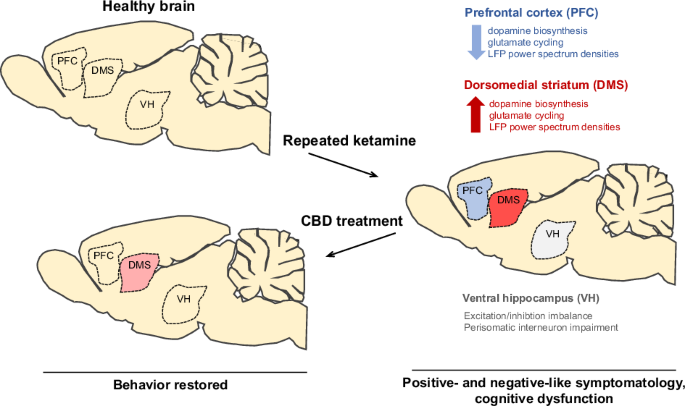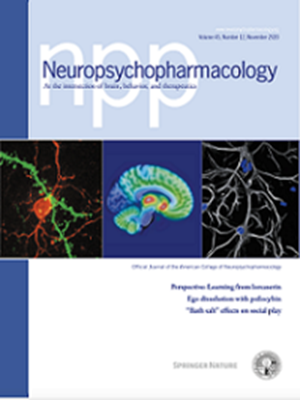Multi-level therapeutic actions of cannabidiol in ketamine-induced schizophrenia psychopathology in male rats
IF 6.6
1区 医学
Q1 NEUROSCIENCES
引用次数: 0
Abstract
Repeated administration of ketamine (KET) has been used to model schizophrenia-like symptomatology in rodents, but the psychotomimetic neurobiological and neuroanatomical underpinnings remain elusive. In parallel, the unmet need for a better treatment of schizophrenia requires the development of novel therapeutic strategies. Cannabidiol (CBD), a major non-addictive phytocannabinoid has been linked to antipsychotic effects with unclear mechanistic basis. Therefore, this study aims to clarify the neurobiological substrate of repeated KET administration model and to evaluate CBD’s antipsychotic potential and neurobiological basis. CBD-treated male rats with and without prior repeated KET administration underwent behavioral analyses, followed by multilevel analysis of different brain areas including dopaminergic and glutamatergic activity, synaptic signaling, as well as electrophysiological recordings for the assessment of corticohippocampal and corticostriatal network activity. Repeated KET model is characterized by schizophrenia-like symptomatology and alterations in glutamatergic and dopaminergic activity mainly in the PFC and the dorsomedial striatum (DMS), through a bi-directional pattern. These observations are accompanied by glutamatergic/GABAergic deviations paralleled to impaired function of parvalbumin- and cholecystokinin-positive interneurons, indicative of excitation/inhibition (E/I) imbalance. Moreover, CBD counteracted the schizophrenia-like behavioral phenotype as well as reverted prefrontal abnormalities and ventral hippocampal E/I deficits, while partially modulated dorsostriatal dysregulations. This study adds novel insights to our understanding of the KET-induced schizophrenia-related brain pathology, as well as the CBD antipsychotic action through a region-specific set of modulations in the corticohippocampal and costicostrtiatal circuitry of KET-induced profile contributing to the development of novel therapeutic strategies focused on the ECS and E/I imbalance restoration.


大麻二酚对氯胺酮诱导的雄性大鼠精神分裂症精神病理学的多层次治疗作用。
重复使用氯胺酮(KET)已被用于在啮齿类动物中建立类似精神分裂症症状的模型,但精神拟态神经生物学和神经解剖学的基础仍然难以捉摸。与此同时,为了更好地治疗精神分裂症,需要开发新的治疗策略。大麻二酚(CBD)是一种主要的非成瘾性植物大麻素,与抗精神病作用有关,但其机理基础尚不清楚。因此,本研究旨在阐明重复 KET 给药模型的神经生物学基础,并评估 CBD 的抗精神病潜力和神经生物学基础。经 CBD 处理的雄性大鼠在重复服用 KET 之前和未重复服用 KET 之前均进行了行为分析,随后对不同脑区进行了多层次分析,包括多巴胺能和谷氨酸能活动、突触信号转导,以及评估皮质海马和皮质纹状体网络活动的电生理记录。重复 KET 模型的特点是出现类似精神分裂症的症状,谷氨酸能和多巴胺能活动发生改变,主要是在前脑皮质和背内侧纹状体(DMS),呈双向模式。伴随这些观察结果的是谷氨酸能/GABA能偏差,与之平行的是副斑蝥素和胆囊收缩素阳性中间神经元功能受损,表明兴奋/抑制(E/I)失衡。此外,CBD还能抵消精神分裂症样行为表型,恢复前额叶异常和腹侧海马E/I缺陷,同时部分调节背侧纹状体失调。这项研究为我们了解 KET 诱导的精神分裂症相关脑病理学以及 CBD 通过对 KET 诱导的皮质海马和脊髓成本神经回路的一系列区域特异性调节而发挥的抗精神病作用提供了新的视角,有助于开发以 ECS 和 E/I 失衡恢复为重点的新型治疗策略。
本文章由计算机程序翻译,如有差异,请以英文原文为准。
求助全文
约1分钟内获得全文
求助全文
来源期刊

Neuropsychopharmacology
医学-精神病学
CiteScore
15.00
自引率
2.60%
发文量
240
审稿时长
2 months
期刊介绍:
Neuropsychopharmacology is a reputable international scientific journal that serves as the official publication of the American College of Neuropsychopharmacology (ACNP). The journal's primary focus is on research that enhances our knowledge of the brain and behavior, with a particular emphasis on the molecular, cellular, physiological, and psychological aspects of substances that affect the central nervous system (CNS). It also aims to identify new molecular targets for the development of future drugs.
The journal prioritizes original research reports, but it also welcomes mini-reviews and perspectives, which are often solicited by the editorial office. These types of articles provide valuable insights and syntheses of current research trends and future directions in the field of neuroscience and pharmacology.
 求助内容:
求助内容: 应助结果提醒方式:
应助结果提醒方式:


